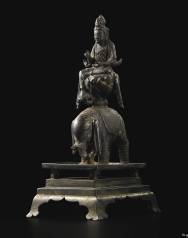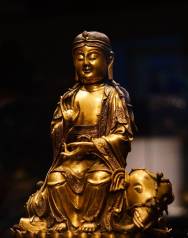侧边栏
普贤菩萨(Samantabhadra)
普贤菩萨, 梵文Samantabhadra,音译为三曼多跋陀罗,曾译为遍吉菩萨,大乘佛教的四大菩萨之一,象征着理德、行德,与象征着智德、正德的文殊菩萨相对应,同为释迦牟尼佛的左、右胁侍。此外,毗卢遮那如来、文殊菩萨、普贤菩萨被尊称为“华严三圣”。
外文描述
Samantabhadra is a bodhisattva known from the Mahayana Sutras. He is most often depicted in art as a member of the group known as the Eight Great Bodhisattvas which include the famous Manjushri, Avalokiteshvara and Vajrapani. Unlike those figures Samantabhadra never gained the popularity and was not elevated in the Tantric literature to the level of a meditational deity (ishtadevata). Samantabhadra the bodhisattva is unrelated to Samantabhadra the primordial Buddha of the Nyingma Tradition of Tibetan Buddhism.
Samantabhadra is rarely if ever depicted alone and his iconographic characteristics are not fixed and often difficult to identify. In descriptive ritual praises (stotra) Samantabhadra is described as red in colour. He holds a vase in the right hand and the symbol of the sun atop a flower blossom held in the left hand. In the tradition of the artist Konchog Pende of E (circa 16th century) Samantabhadra is blue in colour and holds a book with both hands. In the Chinese artistic tradition Samantabhadra is commonly depicted seated atop an elephant. There is also a mountain sacred to Samantabhadra call Omei Shan in Sichuan Province.
相关页面
造像特征
普贤菩萨最常见的形象是身着菩萨装, 头戴五如来冠,身披袈裟,右手执如意或莲花(如意棒是普贤比较明显的特征, 尤其是在没有象的情况下, 有时法器也会是日轮),骑于六牙白象之上(或者宝座上雕有大象),四只象足分别踩在四朵莲花上。六牙白象是普贤形象最重要的标志,用以体现其功德的“谨慎静重”和佛法的大慈力。
常见的普贤菩萨造像按形象可分为:
深度阅读: 普贤菩萨造像沿革
参考文献:
……





